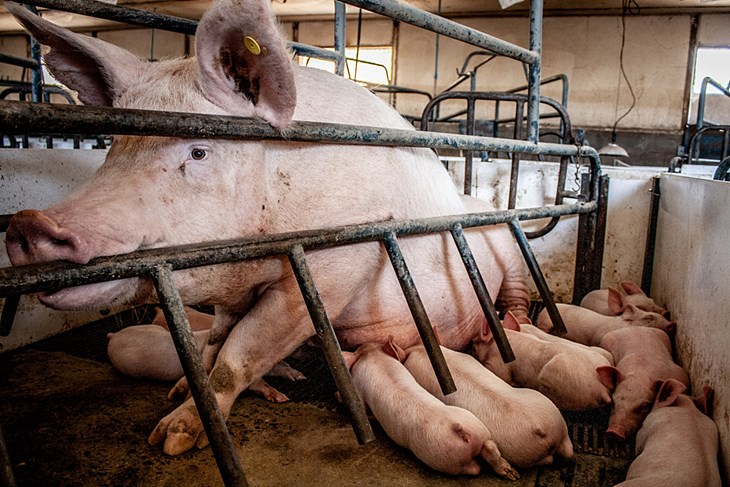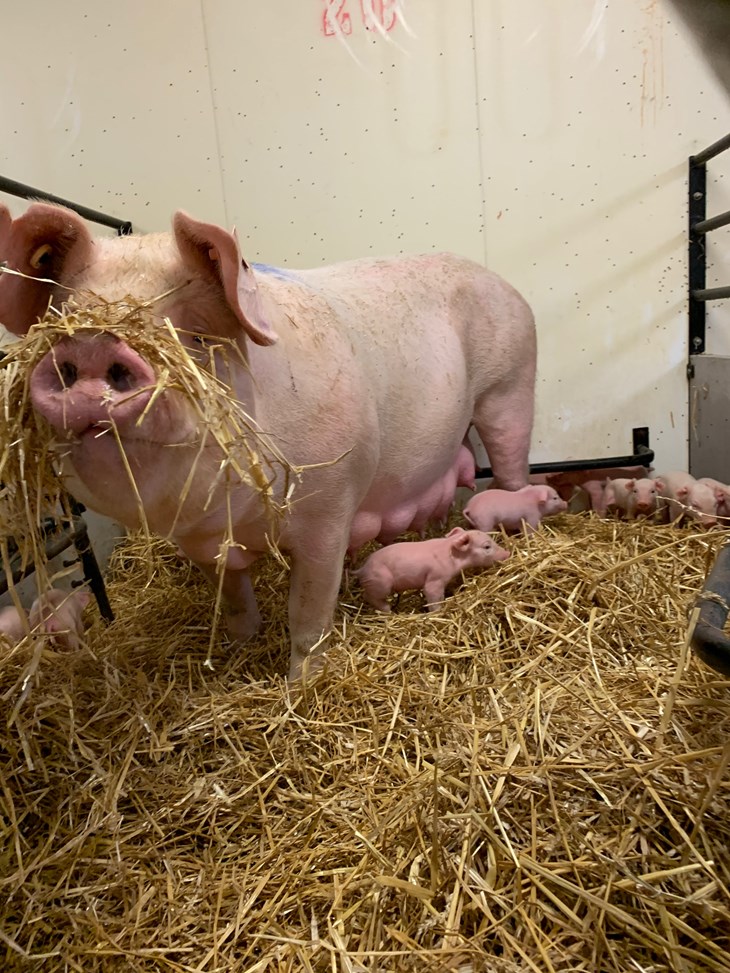10/16/2024
by Ryan Robinson
You may be walking down the aisle at your local grocery store and come across a brand of sausage or bacon that describes the product as “humanely raised”. You may also see a similar brand with no written claims at all but illustrates a seemingly happy pig on the label. Some labels may even be covered front-to-back with nutritional information, welfare labels, and credits to the company’s stance on antibiotics or GMO’s.
Recent surveys indicate that consumers value transparency more than ever, including additional nutritional information, manufacturing processes, and certifications. It can be overwhelming trying to choose what product is “best” when every product – every company – is vying for your attention. As we navigate an increasingly transparent world, it is more crucial than ever to understand what labels, language and policies mean for the animals involved, and in this case, mother pigs.
The life of a factory-farmed mother pig
Millions of mother pigs (commonly called gilts if they’ve never raised a litter of piglets, or sows if they have) are reared and give birth to between 2-3 litters of piglets annually in the United States. They are intelligent, social animals, and protective of their litter. Pigs will often create social structures and hierarchies based on their character, whether more dominant or timid.
When a sow is close to giving birth, her natural instinct is to seclude herself from the rest of the herd, build a nest using fibrous material like straw, hay, or leaves, and “farrow” or birth her piglets. They remain isolated from the herd for a few weeks while she nurses them, protects them and teaches them common behavioral practices before re-introducing them to the herd.

To increase efficiency and reduce sow aggression in overcrowded, stressful, and barren conventional production systems, sows are kept in crates throughout the majority of their lives – both throughout their pregnancy, farrowing (birthing) and weaning of their litters. Known as gestation crates, sows in heat are intensively confined in these 7ft x 2ft rectangular crates, lined up next to each other. These sows – unable to perform basic movements and natural behaviors – become frustrated, engaging in detrimental behaviors such as excessive drinking, biting the bar and sham-chewing (stress-associated behavior of repetitious chewing with no food in the sow’s mouth). Conventionally raised sows are kept in these stress-inducing, inhumane crates for up to 77% of their lifetimes.(i)
The good news is that U.S. production systems – while slow – are transitioning away from intensive confinement and moving toward a crate-free future. Group housing is another production model, where sows are kept in open group pens during the majority of their pregnancy cycles. While this is a step in the right direction, most group housing systems, unless otherwise stated, will still confine sows in gestation crates for up to 35 days of her 114 day pregnancy, until they are “confirmed” pregnant.
This is not the end of the sow's confinement. Approximately one week prior to giving birth, conventionally raised sows are moved to another crating system called farrowing crates. These crates are about the same size as gestation crates but allow piglets to nurse from the mother. Farrowing crates were originally intended to prevent the mother from harming her piglets when she would lay down to nurse but have since taken over as the conventional standard. Once her piglets are fully weaned, the sow is then taken back to gestation crates, where the cycle begins anew.

Progress for pigs
Certification labels matter greatly for the welfare of the pig. Through voluntary auditing programs such as Global Animal Partnership, Certified Humane and Animal Welfare Approved, producers can affirm their animal welfare claims, ensuring transparency and ensuring that sows are never intensively confined. This means each sow can exhibit natural behaviors – like nest building – that improve their overall health, reduce piglet mortality and provide them and their piglets with space to move comfortably. Reputable certification labels also prevent the use of farrowing crates, and these producers will provide private pens with fibrous bedding or pasture space for sows to adequately raise each litter.

How Compassion in World Farming is advocating for mother pigs
Compassion in World Farming works on several fronts to improve farmed animal welfare, from advocating for effective and meaningful policy implementation through our campaigns team, to openly collaborating with companies to raise the standard of animal-sourced food in their supply chain through our Food Business team.
Our newest annual report PigTrack is a resource-driven report focused on companies making and achieving commitments to removing inhumane confinement for sows from their supply chains – transitioning to a more compassionate future. Within the report, you'll read an overview on welfare issues for sows, welfare-friendly alternatives to intensive confinement, features from crate-free companies like Applegate, Pederson's, and Niman Ranch, a certification matrix that compares third-party welfare labels in how they monitor standards of care for sows and much more.
Read our new PigTrack report to learn more about which companies are providing a more compassionate future for mother pigs and check out our Compassionate Food Guide to make more informed choices.


